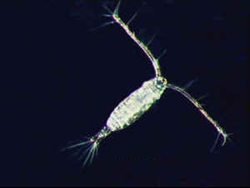Modelling live feed cultures to overcome zoo-technical challenges in production units
We developed a mathematical model to find the perfect depth of water that is required in a copepod culture in order to increase the egg harvest yields. This provides a more cost-effective alternative to intensive experimental work.

We developed a mathematical model to find the perfect depth of water that is required in a copepod culture in order to increase the egg harvest yields. This provides a more cost-effective alternative to intensive experimental work. Using this model can also help to define biological traits, which in turn influence the selection processes.
The intensification of live feed production is affected by the biology of the cultured organisms. The copepod
Acartia tonsa is recognised as the optimal prey for high value fish larvae species such as grouper, cod and tuna. However, the culture systems for this copepod are limited by factors inherent to his biology:
Acartia tonsa release their eggs freely into the water column and tend to cannibalise them.
Using modelling to improve production is a well-known process in other industries, but has never been used in the production of live feed. We developed a unique mathematical model in conjunction with the Oceanographic Laboratory of Villefranche-sur-Mer (France) and as part of the "Sapere Aude - Ung Elitforsk"-Grant from the Danish Council for Independent Research. The model uses data from the literature and helps to find the perfect conditions to increase egg harvest yields.
Finding the proper zoo-technical conditions to produce copepods intensively is important to hatcheries all around the world. These conditions can include densities of copepods and tank sizes. Our mathematical model can help to do just that.
Read more